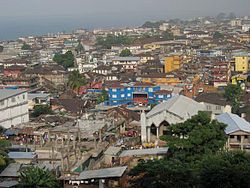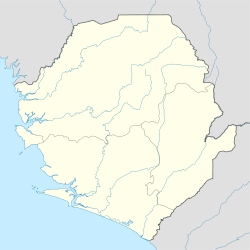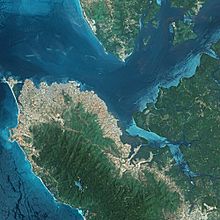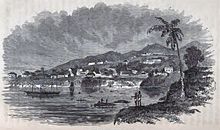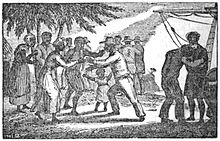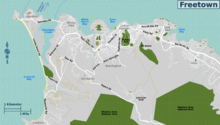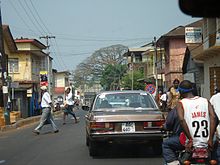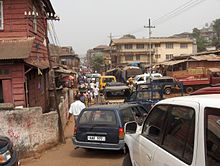
Freetown
About this schools Wikipedia selection
SOS Children made this Wikipedia selection alongside other schools resources. SOS mothers each look after a a family of sponsored children.
| Freetown | |
|---|---|
| View of Freetown | |
|
|
|
| Coordinates: 8°29′4″N 13°14′4″W Coordinates: 8°29′4″N 13°14′4″W | |
| Country | |
| Region | Western Area |
| District | Western Area Urban District |
| Founded | March 11, 1792 |
| Government | |
| • Type | City council |
| • Mayor | Franklyn Bode Gibson ( APC) |
| Area | |
| • Total | 138 sq mi (357 km2) |
| Elevation | 84 ft (26 m) |
| Population (2010) | |
| • Total | 1.2 million |
| Time zone | Greenwich Mean Time |
Freetown is the capital and largest city of Sierra Leone. It is a major port city in the Atlantic Ocean and is located in the Western Area of Sierra Leone. Freetown is Sierra Leone's major urban, economic, financial, cultural, educational and political centre. The city proper had a population of 772,873 at the 2004 census, As of 2010, the population of Freetown is estimated at 1.2 million. The city's economy revolves largely around its harbour - occupying a part of the estuary of the Sierra Leone River in one of the world's largest natural deep water harbours.
Freetown is home to the Fourah Bay College, the oldest university in West Africa, founded in 1827. The university not only played a key role in Sierra Leone’s colonial history, but also a key role in the history of the English-speaking West-African nations.
As the capital of Sierra Leone, Freetown is home to the Sierra Leone House of Parliament, the Supreme Court of Sierra Leone and the State House, the official workplace of the President of Sierra Leone. All of the foreign embassies in Sierra Leone are based in the city.
Freetown is one of Sierra Leone's six municipalities and is locally governed by a directly elected city council, headed by a mayor. The mayor and members of the Freetown city council are directly elected every four years by the residents of Freetown. The municipality of Freetown is politically divided into three regions: East End Freetown, Central Freetown, and West End Freetown, which are subdivided into wards.
The population of Freetown is ethnically, culturally, and religiously diverse among Muslims and Christians. The city is home to a large population of all of the country's ethnic groups, with no single ethnic group forming a majority. As in virtually all parts of Sierra Leone, the Krio language is the city's primary language of communication and is by far the most widely spoken language in the city.
The city of Freetown was founded in 1792 by Abolitionist John Clarkson as a land for freed African American slaves, called the Nova Scotian who had fought on the side with British during the American Revolutionary War . The settlers called their new settlement Freetown, as a land for freed slaves . Around 500 Freed Jamaican slaves made the journey to Freetown in 1800 through the Sierra Leone Company. During the next decades, thousands of freed African American, West Indian and Liberated Africans came to Freetown as settlers, through the Sierra Leone Company . Their descendants are known today as the Sierra Leone Creole people.
History
Province of Freedom 1787–1789
The area was first settled in 1787 by 400 formerly enslaved Black Britons sent from London, England, under the auspices of the Committee for the Relief of the Black Poor, an organisation set up by the British abolitionist, Granville Sharp. They established the 'Province of Freedom' or Granville Town on land purchased from local Koya Temne subchief King Tom and regent Naimbana, a purchase which the Europeans understood to cede the land to the new settlers "for ever." The established arrangement between Europeans and the Koya Temne did not include provisions for permanent settlement, and some historians question how well the Koya leaders understood the agreement.
Disputes soon broke out, and King Tom's successor, King Jimmy, burnt the settlement to the ground in 1789. Alexander Falconbridge was sent to Sierra Leone in 1791 to collect the remaining Black Poor settlers, and they re-established Granville Town (later on renamed Cline Town, Sierra Leone) near Fourah Bay. It should be noted that these 1787 settlers did not establish Freetown. The bicentennial of Freetown was celebrated in 1987, when in reality Freetown was founded in 1792.Shaw, Rosalind, Memories of the Slave Trade: Ritual and the Historical Imagination in Sierra Leone (2002), University of Chicago Press, p. 37.
Freetown Colony 1792–1808
The basis for the Freetown Colony began in 1791, when Thomas Peters, an African American who had served in the Black Pioneers, went to England to report the grievances of the black population. Peters met with the directors of the Sierra Leone Company, and it was there he learned of proposals for a new settlement at Sierra Leone (following the collapse of the 1787 colonization attempt). The directors were eager to allow the Settlers to build a settlement at Sierra Leone; the London-based and newly created Sierra Leone Company had decided to create a new colony but before Peters' arrival had no colonists. Lieutenant John Clarkson was sent to Nova Scotia in British North America to register immigrants to take to Sierra Leone for the purpose of starting a new settlement. Over 1,100 former American slaves from Nova Scotia sailed in 15 ships and arrived in St. George Bay between February 26-March 9. Sixty four settlers died en route to Sierra Leone, and even Lieutenant Clarkson was ill during the voyage. Upon reaching Sierra Leone, Clarkson and some of the Nova Scotian 'captains' "dispatched on shore to clear or make roadway for their landing". The Nova Scotians were to build Freetown on the former site of the first Granville Town which had become a "jungle" since its destruction in 1789. Though they built Freetown on Granville Town's former site, their settlement was not a rebirth of Granville Town, which had been re-established at Fourah Bay in 1791 by the remaining Old Settlers. The women remained in the ships while the Settler men worked tirelessly to clear the land. Lt. Clarkson told the men to clear the land until they reached a large cotton tree. The Settler men toiled and many were scratched and hurt by the shrubbery and bush. After the work had been done and the land cleared all the Nova Scotians, men and women, disembarked and marched towards the thick forest and to the cotton tree, and their preachers (all African Americans) began singing: Awake and Sing Of Moses and the Lamb Wake! every heart and every tongue To praise the Saviour's name The day of Jubilee is come; Return ye ransomed sinners home On March 11, 1792, Nathaniel Gilbert, a white preacher, prayed and preached a sermon under the large Cotton Tree, and Reverend David George preached the first recorded Baptist service in Africa. The land was dedicated and christened 'Free Town' according to the instructions of the Sierra Leone Company Directors. This was the first thanksgiving service in the newly christened Free Town. Eventually John Clarkson would be sworn in as first governor of Sierra Leone. Small huts were erected before the rainy season. The Sierra Leone Company surveyors and the Settlers built Freetown on the American grid pattern, with parallel streets and wide roads, with the largest being Water Street. On August 24, 1792, the Black Poor or Old Settlers of the second Granville Town were incorporated into the new Sierra Leone Colony but remained at Granville Town. Post of the Month: Freetown
It survived being pillaged by the French in 1794, and was rebuilt by the Nova Scotian settlers. By 1798, Freetown had between 300-400 houses with architecture resembling that of the United States-3–4 feet stone foundations with wooden superstructures. Eventually this style of housing (brought by the Nova Scotians) would be the model for the 'bod oses' of their Creole descendants. In 1800, the Nova Scotians rebelled and it was the arrival of the 500 Jamaican Maroons which caused the rebellion to be suppressed. Thirty-four Nova Scotians were banished and sent to either the Sherbro or a penal colony at Gore. Some of these of the Nova Scotians were eventually allowed back into Freetown. After the Maroons captured the rebels, they were granted the land of the Nova Scotian rebels. Eventually the Maroons would have their own district at Maroon Town, Freetown.
Freetown as a Crown Colony 1808–1961
Later on, indigenous inhabitants attacked the colony in 1801, but the British eventually took control of Freetown making it a Crown Colony in 1808, beginning the expansionism that led to the creation of Sierra Leone.
From 1808 to 1874, the city served as the capital of British West Africa. It also served as the base for the Royal Navy's West Africa Squadron which was charged with halting the slave trade. Most of the slaves liberated by the squadron chose to settle in Sierra Leone, and Freetown in particular, rather than return home; thus the population included descendants of many different peoples from all over the west coast of Africa. The Liberated Africans established the suburbs of Freetown Peninsula, and they were the largest group of immigrants which made up the Creole people of Freetown. The city expanded rapidly as many freed slaves settled, accompanied by West Indian and African soldiers who had fought for Britain in the Napoleonic Wars. During World War II, Britain maintained a naval base at Freetown. Descendants of the various freed slaves who landed in Sierra Leone between 1787 and 1792, are called the Creoles. The Creoles play a leading role in the city, even though they are a minority of the overall Sierra Leone population.
Civil war, 1990s
The city was the scene of fierce fighting in the late 1990s. It was captured by ECOWAS troops seeking to restore President Ahmad Tejan Kabbah in 1998, and later it was unsuccessfully attacked by rebels of the Revolutionary United Front.
Government and politics
The city of Freetown is one of Sierra Leone's six municipalities and is governed by a directly elected city council, headed by a mayor, in whom executive authority is vested. The mayor is responsible for the general management of the city. The mayor and members of the Freetown Municipaity are elected directly by the residents of Freetown in every four years.
The government of the Freetown Municipality has been dominated by All People's Congress (APC) since 2004. The APC won the city's mayorship and majority seats in the Freetown city council in both 2004 and 2008 local elections.
In November 2011, Freetown Mayor Herbert George-Williams was removed from office and replaced by counci member Alhaji Gibril Kanu as Acting Mayor; after Mayor Herbert George-Williams and eight others, including the Chief Administrator of the Freetown city council Bowenson Fredrick Philips; and the Freetown city counci Treasurer Sylvester Momoh Konnehi were arrested and indicted by the Sierra Leone Anti-Corruption Commissionon on twenty five counts on graft charges, ranging with conspiracy to commit corruption and misappropriation of public funds . Mayor Herbert George-Williams was acquitted of seventeen of the nineteen charges against him; and was only convicted of two less serious charges by the Freetown High Court judge Jon Bosco Katutsi who gave him a fine .
Acting Mayor Alhaji Gibril Kanu, however, lost the APC nomination for the mayor of Freetown in the 2012 Mayoral elections with 56 votes to council member Sam Franklyn Bode Gibson, who won 106 in a landslide victory
In the national presidential and Parliamentary elections, Freetown is similar to swing states in American politics, primarily due to the city being so ethnically diverse and is home to a significant population of all of the country's ethnic groups; with no single ethnic group forming a majority of the population of the city.
Traditionally, the APC and the SLPP, two of the country's major political parties, have about equal supports in the city. Though, in the 2007 Sierra leone Presidential election, the APC candidate, then main opposition leader, Ernest Bai Koroma, won just over 60% of the votes in the Western Area Urban District, including the city of Freetown, where almost the entire District population reside.
Neighborhoods
The Freetown municipality is politically divided into three regions: East End Freetown, Central Freetown, and West End of Freetown
The wards in the East End of Freetown (East I, East II, and East III) contain the city's largest population centre and generally the poorest part of the city. The Queen Elizabeth II Quay is located within East end.
The two central wards (Central I and Central II) make up Central Freetown which includes Downtown Freetown and the central business district (Central II). Most of the tallest and most important government building and foreign embassies are based in Central Freetown. Sierra Leone's Sierra Leone House of Parliament and the State House, the principle workplace of the president of Sierra Leone, are on Tower Hill in central freetown. At the neighbourhood of Brookfields within central Freetown, sits the National Stadium, the home stadium of the Sierra Leone national football team (popularly known as the Leone Stars).
The three westernmost wards (West I, West II, and West III) of the city constitute the West End of Freetown. These wards are relatively affluent. Most of the city's luxury hotels, a number of casinos, and the Lumley beach are in the west end of the city. The west end neighbourhood of Hill Station is home to the State Lodge, the official residence of the president of Sierra Leone.
Historical attractions
Freetown has an abundance of historically significant landmarks that link the legacy of West Africans with African-Americans, Liberated African slaves, and West Indians. A famous landmark in the centre of the east of Freetown is the Cotton Tree, which is a treasured symbol of the city because it represents the christening of Freetown in March 1792. In downtown Freetown is the Connaught Hospital, which was the first hospital in West Africa modeled after Western medical practices. Nearby is "King's Gate", built in stone with a statement inscribed which reads "any slave who passes through this gate is declared a free man", and it was this gate through which Liberated Africans passed through.
Down by the Naval Wharf are slave steps carved out of stone. It was here that the Portuguese slave traders bought and sold many Africans and from which their last footsteps on African soil were made. Freetown is home to Fourah Bay College, the oldest university in West Africa, founded in 1827. The university played a key role in Sierra Leone’s colonial history. The college’s first student, Samuel Ajayi Crowther, went on to become the first indigenous Bishop of West Africa. Next to the college is the little-visited National Railway Museum, whose prize exhibit is a coach built for the state visit of Elizabeth II in 1961. The Big Market on Wallace Johnson Street is the showcase for local artisans’ work and the place to pick up a bargain souvenir. The Freetown peninsula is ringed by long stretches of white sand. Lumley Beach, on the western side of the peninsula, forms a focal point for local parties and festivals. Freetown is the seat of St John's Maroon Church (built around 1820), St. George Cathedral (completed in 1828), and Foulah Town Mosque (built in the 1830s). Also in Freetown are assorted beaches and markets, and the Sierra Leone Museum featuring the Ruiter Stone.
Economy
Freetown is the economic and financial centre of Sierra Leone. The country's state television and radio station, the Sierra Leone Broadcasting Corporation, is primarily based in Freetown, although they also have regional headquarters in the country's other primary cities of Bo, Kailahun, Kenema, Koidu Town, Magburaka and Makeni. The other national broadcasters such as Capital Radio are also based in Freetown. Freetown is home to one of the country's two main Universities, the Fourah Bay College, the oldest university in West Africa, founded in 1827. Many of the country's largest corporations locate their headquarters' home offices in Freetown as well as the majority of international companies.
The city's economy revolves largely around its fine natural harbor, which is the largest natural harbour on the continent of Africa. Queen Elizabeth II Quay is capable of receiving oceangoing vessels and handles Sierra Leone's main exports. Industries include food and beverage processing, fish packing, rice milling, petroleum refining, diamond cutting, and the manufacture of cigarettes, paint, shoes, and beer. the Fula and Sierra Leonean-Lebanese play a major role in local trade in the city. The city is served by the Lungi International Airport, located in the city of Lungi, across the river estuary from Freetown.
Climate
Like the rest of Sierra Leone, Freetown has a tropical climate with a rainy season from May through to October; the balance of the year represents the dry season. The beginning and end of the rainy season is marked by strong thunderstorms. Under the Köppen climate classification, Freetown has a tropical monsoon climate primarily due to the heavy amount of precipitation it receives during the rainy season. Freetown's high humidity is somewhat relieved November through to February by the famous Harmattan, a gentle wind flowing down from the Sahara Desert affording Freetown its coolest period of the year. Temperature extremes in Freetown are from 21 degrees Celsius (70 degrees Fahrenheit) to 31 degrees Celsius (88 degrees Fahrenheit) all year. Temperatures around 28 degrees Celsius are normal, with very little day/night variation.
| Climate data for Freetown, Sierra Leone | |||||||||||||
|---|---|---|---|---|---|---|---|---|---|---|---|---|---|
| Month | Jan | Feb | Mar | Apr | May | Jun | Jul | Aug | Sep | Oct | Nov | Dec | Year |
| Record high °C (°F) | 33 (91) |
34 (93) |
35 (95) |
35 (95) |
34 (93) |
33 (91) |
32 (90) |
31 (88) |
32 (90) |
33 (91) |
34 (93) |
32 (90) |
35 (95) |
| Average high °C (°F) | 29.9 (85.8) |
30.3 (86.5) |
30.9 (87.6) |
31.2 (88.2) |
30.9 (87.6) |
30.1 (86.2) |
28.7 (83.7) |
28.4 (83.1) |
29.0 (84.2) |
29.9 (85.8) |
30.1 (86.2) |
29.7 (85.5) |
29.92 (85.87) |
| Average low °C (°F) | 23.8 (74.8) |
24.0 (75.2) |
24.4 (75.9) |
24.8 (76.6) |
24.4 (75.9) |
23.6 (74.5) |
23.1 (73.6) |
23.0 (73.4) |
23.1 (73.6) |
23.4 (74.1) |
24.0 (75.2) |
24.1 (75.4) |
23.81 (74.85) |
| Record low °C (°F) | 20 (68) |
21 (70) |
21 (70) |
21 (70) |
21 (70) |
20 (68) |
21 (70) |
20 (68) |
21 (70) |
19 (66) |
20 (68) |
19 (66) |
19 (66) |
| Rainfall mm (inches) | 3.4 (0.134) |
3.6 (0.142) |
12.5 (0.492) |
46.9 (1.846) |
177.2 (6.976) |
323.0 (12.717) |
734.3 (28.909) |
791.1 (31.146) |
484.1 (19.059) |
265.8 (10.465) |
87.5 (3.445) |
15.9 (0.626) |
2,945.3 (115.957) |
| Avg. rainy days (≥ 1.0 mm) | 0 | 0 | 1 | 4 | 15 | 22 | 27 | 27 | 24 | 21 | 9 | 2 | 152 |
| Mean monthly sunshine hours | 226.3 | 217.5 | 232.5 | 207.0 | 189.1 | 153.0 | 102.3 | 86.8 | 126.0 | 186.0 | 204.6 | 161.2 | 2,092.3 |
| Source #1: HKO | |||||||||||||
| Source #2: BBC Weather (records) | |||||||||||||
Religion and language
The population of Freetown is almost equally divided between Muslims and Christians. As in virtually all parts of Sierra Leone, the Krio language (the native language of the Creole people who only make up 5% of country's population) is by far the most widely spoken language in the city. The language is spoken at home as a first language by over 95% of the city's population and is spoken as a lingua franca by the entire population in the city. English (the country's official language) is also widely spoken, particularly by the well educated.
Crime
Since the end of civil war in 2002 Freetown has experienced an increase in robberies, murders, home invasion, and assault. This effect is most pronounced in the East End of Freetown. However, crime levels (especially violent crime) are comparatively low by regional and international standards.
Education
Freetown (as the rest of Sierra Leone) has an education system with six years of primary school (Classes 1 to 6), and six years of secondary school (Forms 1 to 6). Secondary schools are further divided into Junior secondary school (Forms 1 to 3) and Senior secondary school (Forms 4 to 6). This system is known as the 6-3-3-4 education system, which means: 6 years of Primary, 3 years of Junior Secondary, 3 years of Senior Secondary, and 4 years of University. Primary school pupils are usually aged 6 to 12, and secondary schools are usually aged 13 to 18. Primary Education is free and compulsory in government-sponsored public schools. Freetown is home to one of the country's two main universities, the Fourah Bay College, the oldest university in West Africa, founded in 1827.
Notable secondary schools in Freetown
| School | Year Founded |
|---|---|
| Government Rokel Secondary School | |
| Albert Academy | 1904 |
| Annie Walsh Memorial Girls Secondary School | 1849 |
| W.A.M. Collegiate School | |
| St. Edward's Secondary School | 1925 |
| Prince of Wales School Freetown | 1925 |
| Government Model Secondary School | |
| Methodist Boys High School | 1874 |
| Ahmadiyya Muslim Secondary School | 1965 |
| Congress Boys Secondary School | 1975 |
| Government Technical Secondary School | 1957 |
| Sierra Leone Grammar School | 1845 |
| St. Joseph's Secondary School | 1866 |
| Muslim Brotherhood Secondary School | |
| Young Women's Christians Association Secondary School | |
| Freetown Secondary School for Girls | 1926 |
Private Schools:
- Lebanese international school Founded 1956
- Limount College
- International Secondary School
- International Academy of Science and Business Studies
- Dele Preparatory School Founded 1983
- Dele Peddle International High School
- Modern High School
- Modern Elementary School
Transportation
Air transportation
Lungi International Airport is the international airport that serves Freetown and the rest of the country. It is located in the town of Lungi, across the sea from Freetown. It serves as the primary airport for domestic and international travel to or from Sierra Leone. The airport is operated by Sierra Leone Airports Authority. There is a frequent commercial hovercraft, buses and ferry-service to Freetown and other parts of the country.
Transfers to Freetown
Passengers have the choice of hovercraft, ferry, road (5 hours), speedboat, water taxi, local banana boats and helicopter to cross the river to Freetown. Ferry is the cheapest option. Hovercraft and ferry operations have at times been suspended due to passenger overloads and safety issues.
Access by sea
Sierra Leone has the largest natural harbour in the African continent. Ships from all over the globe berth at Freetown's Queen Elizabeth II Quay. Passenger, cargo, and private craft also utilize Government Wharf nearer to central Freetown. Recent investment has seen the introduction of high-tech cargo scanning facilities.
Access by land
Road
Sierra Leone's infrastructure is limited, and its highways and roads reflect this. The roads and highways of the country are administered by the Sierra Leone Roads Authority (SLRA) which has often been crippled by corruption. Highway 1 enters the city from the town of Waterloo several kilometers to the south. Despite the SLRA's limited capabilities, main feeder/trunk roads have been reconstructed to a high standard.
Railway
Following a recommendation from the IBRD, the national railway which linked Freetown to the rest of the country was permanently closed in 1974. The iron rails were looted in the following years.
Sports
Like the rest of Sierra Leone, football is the most popular sport in Freetown. The Sierra Leone national football team, popularly known as the Leone Stars plays all their home games at Freetown's National Stadium, the largest stadium in Sierra Leone. Eight of the fifteen clubs in the Sierra Leone National Premier League are from Freetown, including two of Sierra Leone's biggest and most successful football clubs, East End Lions, and Mighty Blackpool. A match between these two teams is the biggest domestic-football clash in Sierra Leone. A Notable Sierra Leonian footballer is Kei Kamara, who currently plays for Sporting Kansas City of Major League Soccer.
Sierra Leone National Premier League clubs from Freetown
| Club | City |
|---|---|
| East End Lions | Freetown |
| Mighty Blackpool | Freetown |
| Ports Authority F.C. | Freetown |
| F.C. Kallon | Freetown |
| Old Edwardians | Freetown |
| Central Parade | Freetown |
| Golf Leopards | Freetown |
| Mount Aureol | Freetown |
| Real Republicans | Freetown |
Child-care centre
The city hosts the 'We Are the Future center', a child-care center. The centre is managed under the direction of the mayor’s office, and the international NGO Glocal Forum serves as the fundraiser, program planner, and coordinator for the WAF child centre in each city. Each WAF city is linked to several peer cities and public and private partners to create a unique international coalition. Launched in 2004, the program is the result of a partnership between the Glocal Forum, the Quincy Jones Listen Up Foundation, and Hani Masri, with the support of the World Bank, UN agencies, and major companies.
